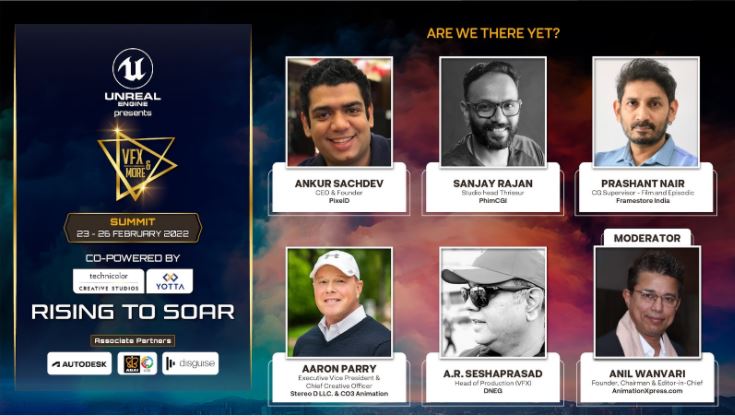Day four of the VAM Summit and Awards witnessed quite an engrossing panel discussion on the topic: ‘Are we there yet?’. The speakers were: PixelD global CEO and founder Ankur Sachdev, PhilmCGI studio head Thrissur Sanjay Rajan, Framestore India CG supervisor film and episodic Prashant Nair, Stereo D LLC. & CO3 Animation executive VP and CCO Aaron Parry, and DNEG production head A.R. Seshaprasad. The session was moderated by AnimationXpress founder, chairman, and editor-in-chief Anil Wanvari.
The panel focussed on discussing whether we have freed ourselves creatively to be able to use our VFX efficiently, have we reached the international standards in terms of usage of processors and workflows, where are the gaps and how are we going to fill them up and more.
Parry initiated the discussion by saying, “We’ve been able to replicate most of our pipelines for VFX, animation and 3D conversions in India. So, I think the skills continue to improve. It is also imperative to have good teaching and sharing from the west.” Multiple big Hollywood studios are now outsourcing video-editing and VFX-based work to Indian studios and this speaks volumes about the fact that we are definitely on the right path and doing well.
“We believe in having a diversity of talents; so we have a good mix of engineers, mathematicians, people from biology, coders, and sculptors. We make sure we work to blend art and technology,” commented Nair when asked what Framestone is doing differently when compared to the other studios. Similarly, Rajan was quick enough to share his studio PhilmCGI’s roadmap, journey, and future plans. He expounded, “We grew during the pandemic and currently have 100-150 VFX artists. Our plan is to go ahead with the domestic work as of now and then grow internationally, that’s our target. We are also planning to open some satellite offices in India.”
Given the growing potential as well as demand in this VFX sector, it becomes imperative to understand the growth prospects, the skill set required, the kind of work this sector has been doing, the challenges and most importantly, find an answer to the question – ‘Is the Indian VFX industry ready to take on the international markets?’ If we take any recent Hollywood release, there are chances that one would find a few Indian names in the credit rolls of the VFX section. Sharing his views on the same, Sachdev was of the opinion that although we are doing exceptionally well, it would be additionally beneficial for us if we dedicate more time and money to our home-grown VFX projects and that our producers need to shell out more cash for better results.
“I would say India’s strengths would be scale, availability of talent, and the ability to deliver because of the hardworking nature of people, dedication, and now even the accessibility of tools. I would also give credit to our education system,” commented Seshaprasad. The Indian VFX studios these days not only support CG content-creation for international movies and TV series for a worldwide broadcast market but also work on domestic projects, which increasingly employ the use of CG.
With audiences now watching Indian content globally via OTT platforms and bigger releases, and Indian content having to compete for eyeballs with content from across the globe, the needs of Indian productions are rivaling those from anywhere. We use the same talent force for a project from the U.S. as one from India. The lines are blurring, and that’s what we want to see from a creative perspective. India is already on the map now, isn’t it? It’s now about high-end skills over the next few years and it sure would be interesting to watch!


